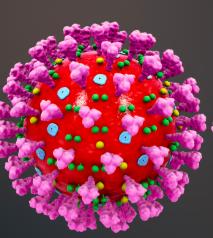
I have what you might call a complicated relationship with viruses. In graduate school, I did virology research, and my first important publication described the discovery of an essential enzyme in the influenza (“flu”) virus. Viruses were hard to grow in the lab, and I became somewhat simpatico with them. However, in medical school, I saw the misery, morbidity, and death that viruses like flu, measles, and hepatitis can inflict. I have been fascinated by viruses ever since, especially as new ones emerge, and the new coronavirus that originated in Wuhan, China, in December is interesting in a number of ways – genetics, epidemiology, evolution, and even public policy.
First, some basic points about outbreaks of infectious diseases, viral illnesses specifically. There are several factors that determine how damaging and worrisome outbreaks will be.
The first is degree of infectiousness, or ability to spread. Examples of the extremes are noroviruses, which can sweep rapidly through an institution or cruise ship, and the rabies virus, which is almost always transmitted to humans through the bite of a warm-blooded animal.
The second is virulence -- the severity or degree of pathogenicity of the infection. Using the same two examples as above, norovirus infections cause severe nausea, vomiting, and diarrhea, but the symptoms are short-lived, and almost never cause significant morbidity if treated symptomatically. Thus, although high in infectivity, they are low in virulence. By contrast, by affecting the brain, rabies gives rise to central nervous system symptoms and is almost always fatal once symptoms occur.
Not surprisingly, the combination that worries us is high levels of both infectiousness and virulence, an example of which would be flu in a bad year – one in which the vaccines aren’t a good match for the viruses circulating in the population, which gives rise to high numbers of illnesses, hospitalizations, and deaths. This flu season in the United States is looking like a pretty average one; the CDC estimates that so far there have been at least 19 million illnesses, 180,000 hospitalizations and 10,000 deaths from flu.
That brings us to the new virus, a member of the coronavirus group, that originated in Wuhan, China. What we would like to know, of course, is where on the spectrums of infectiousness and virulence this virus, officially designated 2019-nCoV, falls. The short answer is that we don’t yet know; the situation is rapidly evolving.
We do know a number of things, however. Coronaviruses cause about 10-30 percent of common colds, and they’re found in many animals, which act as “reservoirs” from which they can jump to humans. Sometimes, this occurs as the result of physical proximity after a genetic mutation, or because of reassortment of segments of genetic material if two kinds of virus infect an animal or person simultaneously.
Over the past 18 years, two other novel coronaviruses emerged from animals, both probably originating from a bat. They caused illnesses called Severe Acute Respiratory Syndrome (SARS) and Middle East Respiratory Syndrome (MERS), respectively. Both had a high mortality rate, which is part of the reason for a high level of concern about 2019-nCoV among scientists and public health officials. Another reason is that the new virus is able to spread from human to human, probably via the respiratory route, given that the symptoms commonly include fever, cough, infiltrates in the lung (that is to say, pneumonia), and respiratory symptoms. There is some evidence that the 2019-nCoV virus might spread from human to human before symptoms develop, which would complicate efforts to control spread – which rely on screening and isolation of people infected and their contacts.
Chinese authorities have reported 564 deaths and 28,060 cases. There are a few hundred confirmed cases around the world, including 11 in the United States. The fatality rate in Wuhan is 4.1 percent and 2.8 percent in Hubei, compared to 0.17 percent elsewhere in mainland China. It was 10 percent with SARS, and 30 to 35 percent with MERS.)
It’s important to note, however, that the number of cases in China counts only hospitalized patients, but not people who are infected but asymptomatic, or who have mild symptoms that seem more like a cold or the flu and who have not sought medical attention. Kits to test for the presence of the virus have been in short supply. Thus, the total number of cases is certainly larger (which would make the fatality rate lower).
There are no FDA-approved antiviral agents that work for coronaviruses and no vaccines, although several to protect against 2019-nCoV is in development. However, given that it’s not yet in clinical trials and FDA’s glacial pace approving drugs administered to large numbers of healthy people, it won’t be a factor for the foreseeable future, if ever. Patients are treated supportively, with fluids and respiratory treatments, as necessary.
For a fluid and potentially dangerous situation such as this, public health officials need to act quickly, decisively, and collaboratively, which seems to be happening. Hubei Province, with a population of 11 million, has become virtually isolated, with no air, train, or bus traffic in or out, and public transportation halted. Some major Chinese cities outside Hubei, including Beijing, have banned all large gatherings. Contacts of patients who test positive for 2019-nCoV are being isolated worldwide. In addition, airports in various countries around the world, including some in the United States and Australia, are screening passengers arriving from Wuhan for fever. Those who are positive undergo secondary screening – for example, with a chest X-ray.
One confounding factor in preventing the spread of infection is that the incubation period — the time from exposure to the onset of symptoms — is long, believed to be as long as two weeks. That means that contacts of active cases could travel long distances before they manifest symptoms.
The bottom line is that for the time being, we need to maintain surveillance, practice good “social engineering” and isolation techniques, and provide appropriate supportive care for infected patients. For now at least, that seems to be working well in this country and others with sophisticated healthcare systems.
Henry I. Miller, a physician and molecular biologist, is a Senior Fellow at the Pacific Research Institute. He was the founding director of the FDA’s Office of Biotechnology.
An earlier version of this article was published in Human Events.



